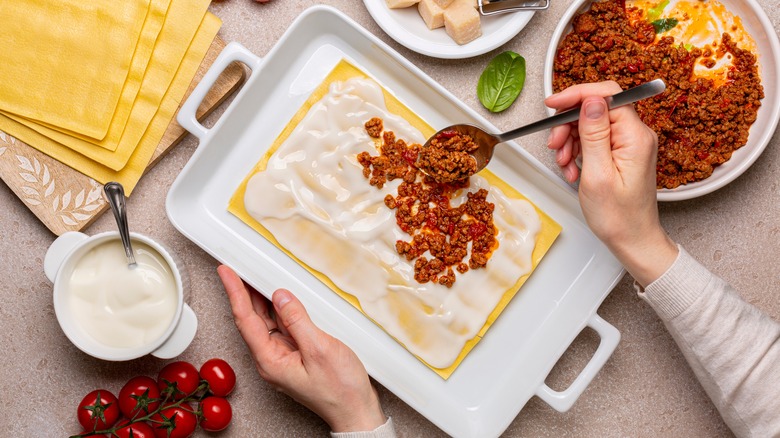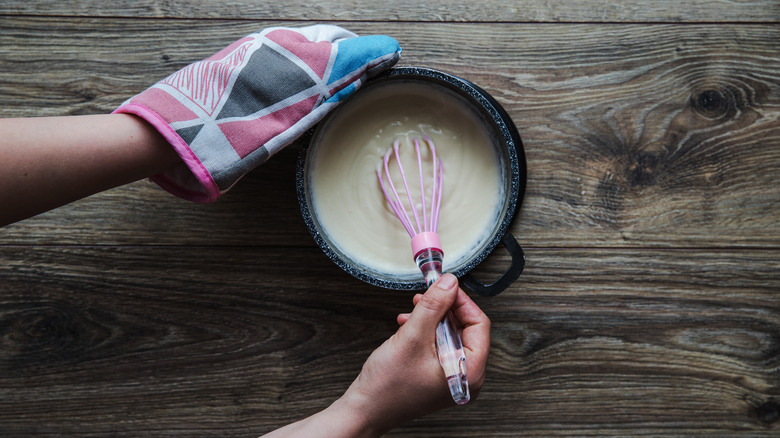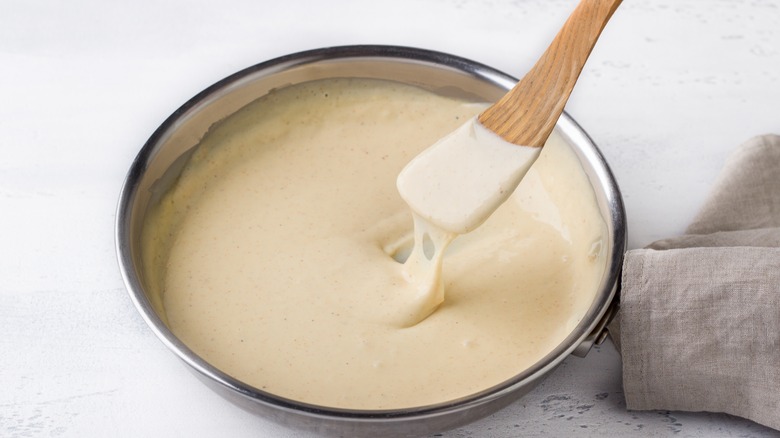For The Best Béchamel Sauce, Break Out Your Griddle
What would lasagna's layers of pasta sheets, Italian sausage, and fresh marinara be without the accompaniment of béchamel sauce? Could moussaka's ground lamb and roasted eggplant comfort the soul without béchamel, bubbling from a quick broiling? Touted as one of the five "mother sauces" of French cooking, béchamel requires minimal ingredients and serves as a starting point for more complex sauces and dishes. After making a roux (or whisking flour into melted butter) slowly whisk in milk as well until the sauce thickens. Add salt and a pinch of nutmeg, and just like that, you have a béchamel ready to support additional flavors — perhaps a heaping cup of Gruyère for mac and cheese.
Considering béchamel's status in the culinary world, chefs have experimented with methods of achieving the creamiest and smoothest sauce for ages. One quality of béchamel, however, can make its cooking more delicate; béchamel burns quickly. Therefore, any technique that allows the sauce to cook through indirect heat can help evade burning. Enter the griddle.
Why you should use indirect heat to make béchamel sauce
Perhaps you reserve your griddle for weekend pancakes, but it can now get more exercise throughout the week. Instead of cooking béchamel on the stovetop directly, try placing a griddle between your burner and saucepan. Ensuring the bottom of the pan does not touch the heat source will allow your sauce the time it needs to heat gradually, critical to the béchamel-making process for two reasons. First, the roux and milk mixture is less likely to stick to the bottom of the pan and burn if the pan never reaches high temperatures. Second, indirect heat allows the milk to slowly incorporate with the bits of roux, resulting in a silkier texture. Introducing heat too quickly may cause the milk to boil before it fully combines with your roux, and you may consequently find clumps of flour in your sauce.
But no need to fret if you don't have a griddle. Other kitchen equipment can help you maintain indirect heat. A double boiler is perfect for tempering chocolate (another food subject to easy burning) because it heats items with only the steam produced by water simmering in its bottom pot. This design works just as well for sauces like béchamel, preventing direct heat from scalding or breaking the sauce.
How to switch up béchamel's flavor
After you pick up the proper heating technique, try exploring variations on béchamel's flavor. Add dijon mustard to béchamel sauce for a tangy note that contrasts the milk and butter's creaminess. Simply stirring in mustard powder could also give the sauce a sharpness if you don't want to include Dijon's vinegar notes. Or, try a yogurt béchamel sauce to not only increase the tang but also boost the sauce's protein factor. While doubling down on dairy may not intuitively seem to make a sauce lighter, yogurt's sourness nicely cuts through the heaviness of béchamel.
If you want to celebrate its traditional preparation, however, béchamel can support a meal on its own without the incorporation of any other herbs, spices, or other additions. Serve béchamel with a loaf of crusty bread on cold winter evenings that only a serving of steamy cream could thaw. Or, let it shine next to garlic-roasted potatoes to elevate the classic side dish. Béchamel sauce is anything but inflexible, after all.



